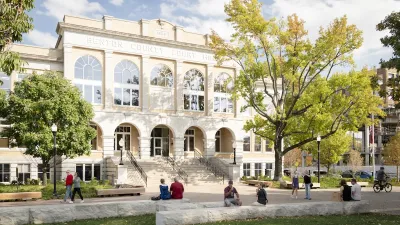New transit stations can have major gentrifying impacts on neighborhoods -- from median income to car ownership rates, according to a recent study.
The study from Northeastern University looked at the impact of new transit stations in 42 neighborhoods in 12 metropolitan areas. Many of them showed signs of gentrification, including rent increases, rise in car ownership and rise in income, according to this summary from Next American City.
"These facts seem to demonstrate that the arrival of a new transit station will result in significant changes in the type of people who inhabit the neighborhood. Of the cities studied, those with light rail were the most likely to see major changes. The evidence related to increases in housing costs, owner-occupation, and automobile ownership seems to suggest that the population of these neighborhoods becomes wealthier over time. (This does not necessarily mean the poorer residents of the neighborhood have moved out; growing populations could mean simply a higher density over time. This study makes an assumption this this transition is happening.) Interestingly, this does not necessarily mean more white: Only half of new transit neighborhoods saw an increase in their white population relative to the region as a whole, with the other half seeing a drop."
FULL STORY: Transit-Friendly Neighbors, Removed from Transit-Friendly Neighborhoods?

Alabama: Trump Terminates Settlements for Black Communities Harmed By Raw Sewage
Trump deemed the landmark civil rights agreement “illegal DEI and environmental justice policy.”

Planetizen Federal Action Tracker
A weekly monitor of how Trump’s orders and actions are impacting planners and planning in America.

The 120 Year Old Tiny Home Villages That Sheltered San Francisco’s Earthquake Refugees
More than a century ago, San Francisco mobilized to house thousands of residents displaced by the 1906 earthquake. Could their strategy offer a model for the present?

Indy Neighborhood Group Builds Temporary Multi-Use Path
Community members, aided in part by funding from the city, repurposed a vehicle lane to create a protected bike and pedestrian path for the summer season.

Congestion Pricing Drops Holland Tunnel Delays by 65 Percent
New York City’s contentious tolling program has yielded improved traffic and roughly $100 million in revenue for the MTA.

In Both Crashes and Crime, Public Transportation is Far Safer than Driving
Contrary to popular assumptions, public transportation has far lower crash and crime rates than automobile travel. For safer communities, improve and encourage transit travel.
Urban Design for Planners 1: Software Tools
This six-course series explores essential urban design concepts using open source software and equips planners with the tools they need to participate fully in the urban design process.
Planning for Universal Design
Learn the tools for implementing Universal Design in planning regulations.
Clanton & Associates, Inc.
Jessamine County Fiscal Court
Institute for Housing and Urban Development Studies (IHS)
City of Grandview
Harvard GSD Executive Education
Toledo-Lucas County Plan Commissions
Salt Lake City
NYU Wagner Graduate School of Public Service





























